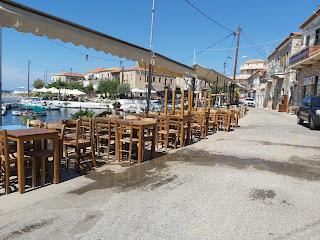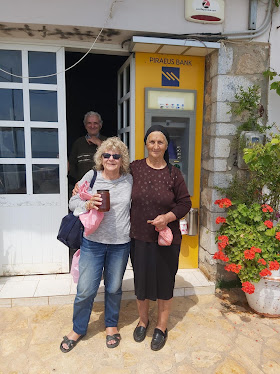Change. It is as inevitable as the passing of seasons.
 |
| Agios Nikolaos, our village |
And now change has come to our village. Slowly at first, it seemed, now picking up speed and with a domino effect. It isn't a single change, mind you, but a gestalt or pattern of changes, that has caused both delight and disappointment among those living in this slice of the Greek Peloponnese.
 |
| Agios Nikolaos, just south of Kalamata |
Our small fishing village is Agios Nikolaos. With a year-round population of a few hundred, it sits on the edge of the Messinian Gulf, cradled in the base of the towering Taygetos Mountains and set amid olive groves. It expands with visitors during the warm months and shrinks back to size in the late fall and winter.
 |
| There is a real estate office in the village now |
The heart of the commercial area of town offers kafenions (coffee shops), bars and eateries. There is a single clothing store, open seasonally. A year-round hardware store and nursery are found a bit out of town, as are two gas stations. A dozen or so fishing boats remain based in our harbor.
As of last year, we also have a real estate office that announced its arrival with the installation of fancy signage. It offers an inventory of homes and property. At least one of those properties posted on that board in the photo is for sale - asking price 850,000 euros.
Yes, change has come to the village.
Change in the Village
.JPG) |
| Captain Antonis and his boat - Agios Nikolaos |
'Kalimera, Captain!' I called out to our friend, Captain Antonis, as he worked on his boat in the harbor. I blew him a kiss as I walked by on the harbor road. 'Kalimera, Jackie!' he called out blowing me a kiss in return. Seeing him and his fishing boat in the harbor and exchanging greetings, is one of the things that hasn't changed in the village.
 |
| We were among the first to take the Captain's excursion |
However, Captain Antonis might actually be one of the village's first change agents. Two years ago, he began taking groups out to experience reeling in the net, sorting the catch, then touring along the coastline, serving lunch and making plenty of swimming or fishing-by-pole-from-the-boat stops before returning several hours later.
While the captain's change was subtle, others can't be missed. The most recent -- and the one seeming to cause angst among expats and soon-to-be-arriving tourists, is the sale of our local supermarket chain.
 |
| Katerina's is closing! |
Let me tell you, if you want to get speculation to an all-time high and nerves jangling among those who don't like change, just start talking about changing the small grocery store chain serving our area. We have two independently owned supermarkets; one of which will continue operating every day but Sunday, as it always has while the other closes temporarily for a change of ownership.
Turns out the news of the sale is true. We wait to learn of the new operating hours. Because our Katerina's market chain is locally owned and it will be different having a new chain operating shops in its place. One of the Katerina's stores - the one in our village -- closed last week for renovation by the new owners.
 |
| Litsa's Katerina's closed this week and will reopen under new ownership |
It and three other Katerina's will open as a Kritikos stores, part of a Greek grocery chain that got its start on the island of Aegina as a mom-and-pop shop decades ago; now with hundreds of stores across the country. We will miss the retiring Litsa who oversaw our small store's operation, but staff members are all returning as employees of the new store. We are among those rather excited about this change, having seen Kritikos outlets elsewhere in Greece and knowing that no one is losing their job.
 |
| Kritikos on the island of Spetses |
Just down the road from the little grocery store, a new upscale restaurant opened in a renovated stone building along the harbor where a long-time favorite, but seasonal, restaurant had operated for years. While we miss the traditional restaurant, the new one, Medikon, quickly became a favorite of ours and others. As a full-time resident here, I can tell you it is nice to have year-round-eating-out options in the village.
 |
| Dining at Medikon - interior courtyard |
The food is so good there, that on our recent cruise we found ourselves comparing a specialty dining venue on the ship with our hometown eatery as being, 'as good as Medikon!' We no longer need to travel to Athens for a fine dining experience. Change has come to the village.
 |
| Souvlaki, pizza and Medikon - our harbor is lined with new eateries |
Next door to Medikon, a pizza place - a sister to the one in neighboring village Stoupa - opened a couple years ago. Then the souvlaki place next to it changed ownership earlier this year and expanded its operation and waterfront presence. The souvlaki place even offers home delivery!
Growing Pains
We've found the most difficult part of change has been the goodbye's it has brought with it. We welcome the new but miss the old familiar faces and hangouts.
 |
| My friend Aspacia - a casualty of change? |
Many of you have come to know through these posts my friend, Aspacia, who lived next to the ATM. It is this woman with whom I exchanged plant starts and hugs throughout the year. She spoke no English and my Greek was limited. I gave her a poinsettia each Christmas, she gave me fresh eggs. She and her husband sold honey from their home. One day they were there, it seemed, and the next day construction was underway.
 |
| New home of something - but not Aspacia |
A sleek glass door now leads into a renovated space where they made their home for the decade we've been here. No one in the village seems to know where they have gone. Nor what is going into the commercial space.
But it was the closing of Gregg's Plateia in January, that probably sent the most shock waves through not only this village but neighboring villages as well. For 15 years it had been the place you went when you needed food, drink, help, advice, a laugh or a hug. Gregg, his mom Freda, wife Kathy, and their sons, along with longtime employee, Nikki, were celebrated at an impromptu closing party where well wishes were offered, and tears were shed.
 |
| Our visitors always made a stop at Gregg's Plateia |
The business closed and the building is being renovated. It will house a meze restaurant owned by the same people who opened Medikon. Gregg has just announced he will begin a transfer service, taking passengers to and from Athens and Kalamata. Freda is enjoying time with family in Australia.
 |
| No one was a stranger at Gregg's - Freda and a guest from Arizona |
We are all eager to try the new place, yet nearly six months later, it doesn't seem right not having Gregg's Plateia in the village.
 |
| The bus still inches through town at least twice a day!! |
Maybe COVID lockdown gave rise to the changes. Maybe it has been the impact of the growing numbers of expats - those like us -- who've been charmed by the place and want more than a vacation-sized serving of life here.
Maybe it is the Greek government's push to expand tourism to year-round and in still-developing tourist destinations. In May the Peloponnese Tourism folks and the City of Kalamata hosted a conference of more than 300 travel writers, bloggers, content producers, and influencers as we are all called now. I can assure you, those attending loved what they saw of this area!
 |
| Agios Nikolaos |
Did I mention that we now have a hang-gliding launch pad in the village behind Agios Nikolaos and its not unusual to have a glider land near Pantazi Beach, just to the south of the village?
That's it for this week. Thanks for being with us again - hope you will be back next time when I ponder expat life. We have heard from many of you and it seems you are contemplating expat life in Greece. It may be time to tell you a bit more about it - the good, the bad and the ugly! Safe travels to you and yours

































